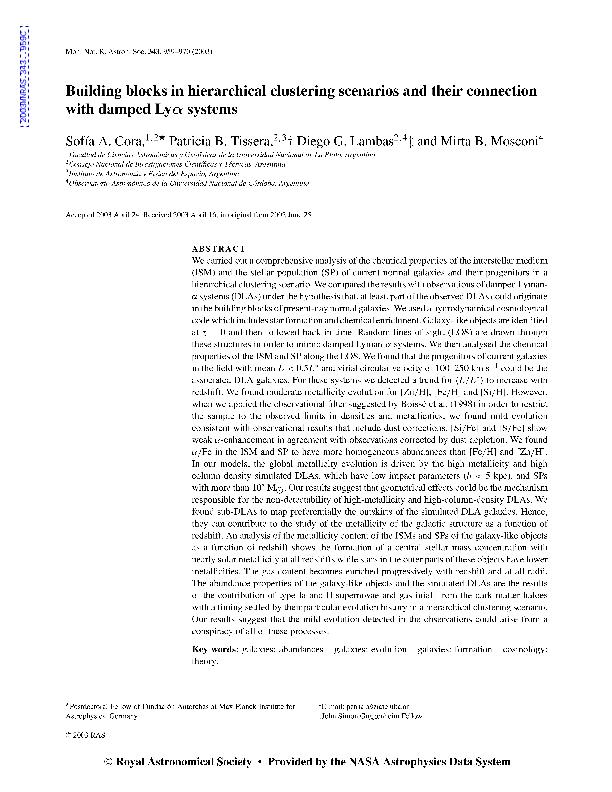Mostrar el registro sencillo del ítem
dc.contributor.author
Cora, Sofia Alejandra

dc.contributor.author
Tissera, Patricia Beatriz

dc.contributor.author
Garcia Lambas, Diego Rodolfo

dc.contributor.author
Mosconi, Mirta B.
dc.date.available
2017-08-14T19:27:07Z
dc.date.issued
2003-12
dc.identifier.citation
Cora, Sofia Alejandra; Tissera, Patricia Beatriz; Garcia Lambas, Diego Rodolfo; Mosconi, Mirta B.; Building blocks in hierarchical clustering scenarios and their connection with damped Lyα systems; Oxford University Press; Monthly Notices of the Royal Astronomical Society; 343; 3; 12-2003; 959-970
dc.identifier.issn
0035-8711
dc.identifier.uri
http://hdl.handle.net/11336/22332
dc.description.abstract
We carried out a comprehensive analysis of the chemical properties of the interstellar medium (ISM) and the stellar population (SP) of current normal galaxies and their progenitors in a hierarchical clustering scenario. We compared the results with observations of Damped Lyman-α systems (DLAs) under the hypothesis that, at least, part of the observed DLAs could originate in the building blocks of today normal galaxies. We used a hydrodynamical cosmological code which includes star formation and chemical enrichment. Galaxy-like objects are identified at z = 0 and then followed back in time. Random line-of-sights (LOSs) are drawn through these structures in order to mimic Damped Lyman α systems. We then analysed the chemical properties of the ISM and SP along the LOSs. We found that the progenitors of current galaxies in the field with mean L < 0 .5 L∗ and virial circular velocity of 100 −250 km /sec could be the associated DLA galaxies. For these systems we detected a trend for hL/L ∗ito increase with redshift. We found moderate metallicity evolution for the [Zn/H], [Fe/H] and [Si/H]. However, when we applied the observational filter suggested by Boiss´e et al. (1998) in order to restrict the sample to the observed limits in densities and metallicities, we found mild evolution consistent with observational results that include dust corrections. The [Si/Fe] and [S/Fe] show weak α-enhancement in agreement with observations corrected by dust depletion. We found the α/Fe in the ISM and SP to have more homogeneous abundances than the [Fe/H] and [Zn/H] ones. In our models, the global metallicity evolution is driven by the high metallicity and high column density simulated DLAs which have low impact parameters (b < 5 kpc) and SPs with more than 10 8M⊙. Our results suggest that geometrical effects could be the mechanism responsible for the non-detectability of high metallicity and high column density DLAs. We found sub-DLAs to map preferentially the outskirts of the simulated
DLA galaxies. Hence, they can contribute to the study of the metallicity of the
galactic structure as a function of redshift. An analysis of the metallicity content of
the ISMs and SPs of the galaxy-like objects as a function of redshift show the formation of a central stellar mass concentration with nearly solar metallicity at all redshift while stars in the outer parts of these objects have lower metallicities. The gas content gets enriched progressively with redshift and at all radii. The abundance properties of the galaxy-like objects and the simulated DLAs are the results of the contribution of supernovae type Ia and type II and gas infall from the dark matter haloes with a timing settled by their particular history of evolution in a hierarchical clustering scenario. Our results suggest that the mild evolution detected in the observations could arise from a conspiracy of all these processes.
dc.format
application/pdf
dc.language.iso
eng
dc.publisher
Oxford University Press

dc.rights
info:eu-repo/semantics/openAccess
dc.rights.uri
https://creativecommons.org/licenses/by-nc-sa/2.5/ar/
dc.subject
Hierarchical
dc.subject
Clustering
dc.subject
Systems
dc.subject
Scenarios
dc.subject.classification
Astronomía

dc.subject.classification
Ciencias Físicas

dc.subject.classification
CIENCIAS NATURALES Y EXACTAS

dc.title
Building blocks in hierarchical clustering scenarios and their connection with damped Lyα systems
dc.type
info:eu-repo/semantics/article
dc.type
info:ar-repo/semantics/artículo
dc.type
info:eu-repo/semantics/publishedVersion
dc.date.updated
2017-08-10T14:07:29Z
dc.journal.volume
343
dc.journal.number
3
dc.journal.pagination
959-970
dc.journal.pais
Reino Unido

dc.journal.ciudad
Londres
dc.description.fil
Fil: Cora, Sofia Alejandra. Universidad Nacional de la Plata. Facultad de Ciencias Astronómicas y Geofísicas; Argentina. Consejo Nacional de Investigaciones Científicas y Técnicas; Argentina
dc.description.fil
Fil: Tissera, Patricia Beatriz. Consejo Nacional de Investigaciónes Científicas y Técnicas. Oficina de Coordinación Administrativa Ciudad Universitaria. Instituto de Astronomía y Física del Espacio. - Universidad de Buenos Aires. Facultad de Ciencias Exactas y Naturales. Instituto de Astronomía y Física del Espacio; Argentina
dc.description.fil
Fil: Garcia Lambas, Diego Rodolfo. Consejo Nacional de Investigaciones Científicas y Técnicas. Centro Científico Tecnológico Conicet - Córdoba. Instituto de Astronomia Teórica y Experimental. Universidad Nacional de Córdoba. Observatorio Astronómico de Córdoba. Instituto de Astronomia Teórica y Experimental; Argentina
dc.description.fil
Fil: Mosconi, Mirta B.. Universidad Nacional de Cordoba. Observatorio Astronomico de Cordoba; Argentina
dc.journal.title
Monthly Notices of the Royal Astronomical Society

dc.relation.alternativeid
info:eu-repo/semantics/altIdentifier/url/https://academic.oup.com/mnras/article-lookup/doi/10.1046/j.1365-8711.2003.06738.x
dc.relation.alternativeid
info:eu-repo/semantics/altIdentifier/doi/http://dx.doi.org/10.1046/j.1365-8711.2003.06738.x
Archivos asociados
